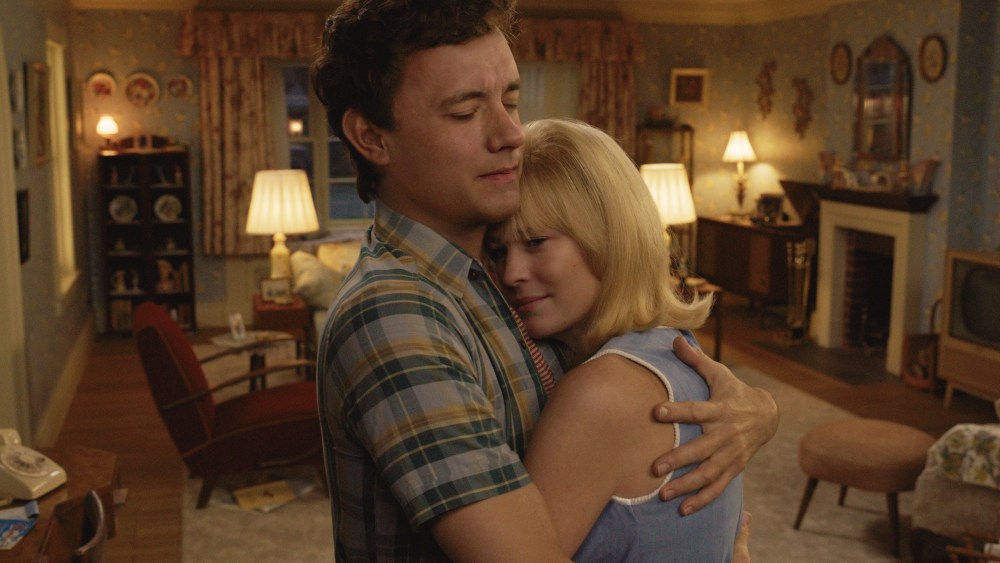Robert Zemeckis Breaks Down Aging Tech in Tom Hanks Movie
Three decades after making “Forrest Gump,” director Robert Zemeckis is once again looking back in time and pushing filmmaking boundaries as he reteams with Tom Hanks and Robin Wright for his latest effort, “Here.”
Hanks and Wright play a married couple who are seen at many ages and life stages in the film, thanks to Zemeckis’ deft use of bleeding edge techniques including an AI-assisted aging and de-aging process to convey a lifetime. That meant paying meticulous attention to the specificity of a person’s body movements at a given age. To cite but one example, how one bounces off a couch as a nimble teenager is very different from how that same person gets up from a couch as a 60-something.
“You had to gear up for, in the morning you’re going to be 17, and in the afternoon you’re going to be 22,” Hanks tells Variety.
Hanks prepared for his role as Richard by exploring how a person’s mental acuity changes over time.
“At the age of 17, you do not realize you’re living in your past. And at the age of 22, you do not realize that you’re making decisions that are going to be signposts for what your future is,” Hanks observes. “Between having to be agile and clueless, that’s the magic recipe of approaching the scenes.”
Based on the 2014 graphic novel by Richard McGuire, “Here” is a unique story that Zemeckis describes as a “meditation on life.” The story unfolds in a single spot from a single camera position, from dinosaurs roaming the ground where a home is later constructed and where families spend decades of their lives. This meant following characters including Richard and Wright’s Margaret from their teenage years into old age through vignettes that (in keeping with the design of the novel) occur from a single camera position and transition through a series of portrait panels that open up, rather than through hard cuts, and in a nonlinear fashion. To pull this off, invention was necessary.
“We could not have made this movie five years ago,” Zemeckis tells Variety of the drama, which TriStar releases Friday. “It’s seamless to the audience, and it flows very organically,” cinematographer Don Burgess (“Forrest Gump”) says of the production, before admitting, “I said, ‘Bob, this could be the most complicated movie you and I’ve ever done together.’”
It might seem appropriate that the inventive director behind films including “Who Framed Roger Rabbit” and “Back to the Future” has once again introduced Hollywood to new filmmaking techniques, but while he acknowledges that he’s sometimes portrayed as a “technology director,” he shrugs off this description. “I don’t know how to run computers or anything like that, but I do love the tools of filmmaking. I love having all the tools of filmmaking at my disposal,” Zemeckis says.
VFX supervisor Kevin Baillie says the team tested the latest aging and de-aging approaches before choosing to work with AI startup Metaphysic. “It becomes part of the production process, rather than getting in the way of it,” he says. “This technology doesn’t require dots on faces. It doesn’t require multiple witness cameras or any other sort of intrusive technology.”

“Here” director Robert Zemeckis, left, with stars Robin Wright and Tom Hanks
Sony Pictures
This allowed the actors to simply focus on their performances, he says. Hanks elaborates that this included the physicality of the roles in the single camera style. The actor relates that he went back and watched films from the 1930s and ’40s, particularly those of Preston Sturges. “I realized that so much of these scenes are shot essentially in the same sort of masters as we did here… Because of that, it stays very active, physically and attention wise.”
It’s so out-of-the-box that Zemeckis and Eric Roth (“Forrest Gump”) wrote the screenplay on spec.
“We knew no one in the current Hollywood would ever pay to develop something like this,” the director admits, adding that he envisioned each actor playing their part at the various ages throughout the film for clarity. When they started the script, he didn’t know how this would be achieved, but by completion, technology had caught up with his imagination and there was a method with which he felt he could age or de-age the actors (also including Kelly Reilly and Paul Bettany, who play Richard’s parents) through roughly 40 minutes of the film’s run time and in a convincing way (particularly as Hanks and Wright are so recognizable at various ages through their body of work), while staying on a lean $45 million budget fully financed by Miramax.
As part of the process, behind the camera during production Zemeckis had two monitors — one for the director to see what was actually being shot and a second that allowed him to see the basic “face swap” in real time on up to two actors at a time. “It was all really rudimentary but you saw enough of it,” the director explains. “It was a great tool for me and the actors. … Seeing it in real time helped the performance immensely. The thing that makes the illusion work is their performance.”
Of seeing her younger self, Wright remembers that it captured “the innocence in the eyes taken from interviews that we had done at that age.”
Referring to the technique as “digital makeup,” Zemeckis relates that production also involved hair styling and makeup (including prosthetics) led by Oscar winning makeup and hair designer Jenny Shircore as well as costume design headed by Joanna Johnston. “It’s not like any one department is being eliminated. The hair people, the makeup people, the digital people — they all work together,” he says.
Baillie elaborates that the ability to see the basic effect on set helped to address a challenge that has been discussed around movies that used aging and deaging techniques, such as “The Irishman.”
“It’s such a labor-intensive process, typically, you’ll shoot the movie using your best guess as to whether the actor’s body motion is really syncing up with the age that they’re supposed to be.” This process, he says, gave them a more precise idea of what they were filming.
Off-set, the team at Metaphysic included data science pros who trained models from curated photos and film clips of the actors at their various ages (he confirms that the production obtained the rights to use all sourced material). Compositors and animators completed the shots during postproduction. “It’s not a creative tool. It’s a tool for creatives,” Baillie asserts. “We always had to have artists’ eyes on it to make sure that it is being faithful to the performance of the actors.”
He continues, “We involved every one of the actors super heavily throughout the process. As part of that process, we sat down with all four actors, and I kind of interviewed them and just talked to them, and then we used that to help kind of prototype [the work]. Then we could then show them ‘here’s what your likeness is going to look like’ and really involve them in the process, kind of curating their own image.”
This wasn’t the only production challenge to making “Here.” Zemeckis also told the story from one fixed view. “It turns out to be maybe the most difficult movie we ever made,” he says. “Every single scene and every single moment had to happen and work perfectly in this frame.”
The tight, 33-day shoot took place at Pinewood Studios in the U.K., with two sets for the interior of the home so that they could film on one while the other was being prepared for the next scene.
“Bob always referred to our room and its environment as a character in itself and he was right in every way,” production designer Ashley Lamont says, explaining that they created a timeline to map out the journey. “Not only do we have multiple looks for each of our families, eras and so on, we also have the day-to-day differences. The subtle changes between scenes, hours, days or years apart, within the same eras. This meant the room was constantly evolving as we moved through each look with some incredibly nuanced redresses.”
Burgess chose to shoot the movie with the Red Raptor and carefully selected Panavision 35 millimeter lens. An LED wall positioned behind the window in the room provided backgrounds as well as a lighting source for the room. Burgess notes, “Bob wanted to see just enough ceiling to feel that ceiling brings you into that space and feel more like you’re in the room with the characters, and you’re living this generational drama with them.”
Wright says that before production, each scene was rehearsed with a locked off video camera. “We blocked the scenes months before we started shooting the movie. [On set] we’d go back and look at each take, because there’s no cut, there’s no other angles.”
A close up, therefore, occurs when an actor walks into and fills the frame. Says Zemeckis, “when an actor walks into a close up, you’re seeing it in a pure way.” For all of the complexity, the team was drawn to the story. “It’s ‘Here’ as in, right here. This happened here, and that odd stacking of events and time ends up being sort of like everybody’s story inside it,” Hanks says. “They’re meeting, they’re falling in love, they’re having babies, they have traditions.” He adds that the way their story begins and ends, with an elderly Richard saying ‘This was our home. We lived here,’ “it’s that Gestalt understanding of an entire lifetime that goes by in the blink of the eye. That’s pretty heavy stuff.”


